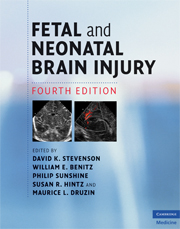Book contents
- Frontmatter
- Contents
- List of contributors
- Foreword
- Preface
- Section 1 Epidemiology, pathophysiology, and pathogenesis of fetal and neonatal brain injury
- Section 2 Pregnancy, labor, and delivery complications causing brain injury
- 5 Prematurity and complications of labor and delivery
- 6 Risks and complications of multiple gestations
- 7 Intrauterine growth restriction
- 8 Maternal diseases that affect fetal development
- 9 Obstetrical conditions and practices that affect the fetus and newborn
- 10 Fetal and neonatal injury as a consequence of maternal substance abuse
- 11 Hypertensive disorders of pregnancy
- 12 Complications of labor and delivery
- 13 Fetal response to asphyxia
- 14 Antepartum evaluation of fetal well-being
- 15 Intrapartum evaluation of the fetus
- Section 3 Diagnosis of the infant with brain injury
- Section 4 Specific conditions associated with fetal and neonatal brain injury
- Section 5 Management of the depressed or neurologically dysfunctional neonate
- Section 6 Assessing outcome of the brain-injured infant
- Index
- Plate section
- References
14 - Antepartum evaluation of fetal well-being
from Section 2 - Pregnancy, labor, and delivery complications causing brain injury
Published online by Cambridge University Press: 12 January 2010
- Frontmatter
- Contents
- List of contributors
- Foreword
- Preface
- Section 1 Epidemiology, pathophysiology, and pathogenesis of fetal and neonatal brain injury
- Section 2 Pregnancy, labor, and delivery complications causing brain injury
- 5 Prematurity and complications of labor and delivery
- 6 Risks and complications of multiple gestations
- 7 Intrauterine growth restriction
- 8 Maternal diseases that affect fetal development
- 9 Obstetrical conditions and practices that affect the fetus and newborn
- 10 Fetal and neonatal injury as a consequence of maternal substance abuse
- 11 Hypertensive disorders of pregnancy
- 12 Complications of labor and delivery
- 13 Fetal response to asphyxia
- 14 Antepartum evaluation of fetal well-being
- 15 Intrapartum evaluation of the fetus
- Section 3 Diagnosis of the infant with brain injury
- Section 4 Specific conditions associated with fetal and neonatal brain injury
- Section 5 Management of the depressed or neurologically dysfunctional neonate
- Section 6 Assessing outcome of the brain-injured infant
- Index
- Plate section
- References
Summary
Introduction
In the USA, nearly 50% of all perinatal death occurs prior to birth. While fetal death from acute events such as cord accidents cannot be predicted, identifying, testing, and intervening for the fetus at risk for chronic in utero compromise may prevent neonatal and infant morbidity. This chapter discusses the antenatal assessment of fetal well-being.
An antepartum fetal test should reduce perinatal morbidity and mortality, and reassure parents. The test of choice depends on gestational age. When a fetus at risk for acidosis and asphyxia has reached viability, one of several tests may be employed for screening, including the non-stress test (NST), the contraction stress test (CST), fetal movement monitoring, the biophysical profile (BPP), and Doppler ultrasound. The sensitivity of these tests is generally high, while the specificity is highly variable. Diagnostic ultrasound and prenatal diagnostic procedures such as chorionic villus sampling (CVS) or amniocentesis are the most common tests performed during the early stages of pregnancy to identify chromosomal or major fetal anomalies.
The purpose of this chapter is to discuss common antepartum screening tests, including a description of each test, its indication, and its accuracy.
- Type
- Chapter
- Information
- Fetal and Neonatal Brain Injury , pp. 163 - 173Publisher: Cambridge University PressPrint publication year: 2009

